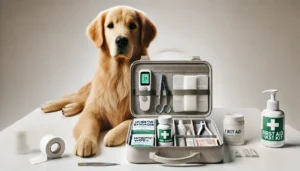Table of Contents
Introduction
One moment, your dog is happily romping through the grass, tail wagging with delight. The next, they’re scratching incessantly, twisting and turning in discomfort. If you’ve ever wondered how dogs get fleas and why these tiny parasites cause so much trouble, you’re not alone. Fleas are one of the most common external parasites affecting dogs worldwide, and their ability to spread rapidly makes them a persistent problem for pet owners.
Fleas are not just a nuisance. Beyond the constant itching and scratching, they can cause flea allergy dermatitis (FAD), anemia, and even transmit dangerous diseases such as tapeworms (Dipylidium caninum) and bacterial infections like Bartonella (cat scratch fever) (PetMD). In some rare cases, fleas have even been linked to the transmission of Yersinia pestis, the bacterium responsible for plague (Nature).
Understanding how fleas infest dogs, the risks they pose, and the most effective ways to prevent and treat them is crucial for keeping your pet happy and healthy. This guide will cover everything you need to know about flea infestations, from their lifecycle and transmission to the best prevention and treatment methods recommended by veterinarians.
Section 1: How Do Dogs Get Fleas?
1.1 What Are Fleas?
Fleas are small, wingless insects that survive by feeding on the blood of their hosts. The most common flea species affecting dogs is the cat flea (Ctenocephalides felis), which, despite its name, infests dogs, cats, and even wildlife (Mississippi State University Extension). These tiny parasites are remarkably resilient, capable of jumping over 100 times their body length, making it easy for them to move between hosts.
Once a flea finds a suitable host, it begins feeding almost immediately. Adult fleas can consume up to 15 times their body weight in blood per day, leading to potential health issues such as anemia in severe infestations. Fleas reproduce at an alarming rate, with a single female flea laying up to 50 eggs per day, making swift treatment and prevention critical (CDC).
1.2 The Flea Lifecycle: How Infestations Start
To effectively combat fleas, it’s essential to understand their lifecycle. Fleas go through four distinct stages:
- Egg – Laid on the host but often fall into carpets, pet bedding, and outdoor environments.
- Larva – Tiny, worm-like larvae hatch and feed on organic debris, including adult flea feces.
- Pupa – Larvae cocoon themselves in a protective casing, where they can remain dormant for weeks or even months until they detect vibrations, heat, or carbon dioxide from a potential host.
- Adult – Once a flea emerges from the pupa, it immediately seeks a host, starting the cycle again.
The ability of flea pupae to stay dormant for extended periods is why flea problems can suddenly reappear even after a home seems flea-free (PetMD).
1.3 How Fleas Find Their Way Onto Dogs
Dogs can pick up fleas from multiple sources, including:
- Direct contact with other animals – Fleas easily transfer from one animal to another during social interactions, such as playing with other dogs or encountering wildlife like squirrels and raccoons.
- Contaminated environments – Fleas thrive in warm, humid areas, hiding in grass, carpets, furniture, and pet bedding. They can jump onto your dog as they pass through infested areas.
- Hitchhiking on humans – Fleas can attach to clothing, shoes, and even human skin, unknowingly being carried into homes.
- Boarding facilities, dog parks, and groomers – Areas where multiple pets congregate can be hotspots for flea transmission.

Since fleas don’t require direct contact with an infested animal to spread, prevention is essential even if your dog spends most of its time indoors (Mississippi State University Extension).
Section 2: Why Fleas Are a Serious Problem
2.1 Health Risks Associated With Fleas
Many pet owners assume fleas are just an itchy inconvenience, but untreated infestations can cause serious health issues, including:
Flea Allergy Dermatitis (FAD)
- A common allergic reaction to flea saliva that causes intense itching, redness, and hair loss.
- Dogs with FAD often develop secondary skin infections from excessive scratching and biting.
Anemia and Blood Loss
- Since fleas consume large amounts of blood, severe infestations can lead to anemia, particularly in puppies, elderly dogs, and small breeds.
- Symptoms of anemia include weakness, pale gums, and lethargy (PetMD).
Disease Transmission
Fleas are vectors for several dangerous diseases, including:
- Tapeworms (Dipylidium caninum) – Fleas carry tapeworm larvae, which can infect dogs when they ingest a flea while grooming.
- Bartonella (“Cat Scratch Fever”) – While more common in cats, fleas can transmit Bartonella bacteria to dogs, leading to fever, swollen lymph nodes, and lethargy.
- Plague (Yersinia pestis) – Although rare, fleas have historically been responsible for plague transmission. Recent studies indicate that Y. pestis may persist in flea populations longer than previously believed (Nature).
2.2 Geographic & Environmental Factors
Flea prevalence varies by geographic location and climate:
- Warm, humid environments (e.g., Southeast Asia, the Southern U.S.) allow fleas to thrive year-round.
- Cooler climates experience seasonal flea activity, but central heating in homes can support fleas indoors even in winter.
- In some regions, fleas co-exist with ticks, increasing the risk of vector-borne diseases like Lyme disease (National Library of Medicine).
Since fleas can survive indoors, pet owners in all climates must take year-round preventative measures to avoid infestations.

Section 3: How to Protect Your Dog From Fleas
The best way to deal with fleas is to stop infestations before they start. A comprehensive flea prevention strategy includes using veterinarian-approved flea control products, maintaining a clean environment, and addressing any potential flea hotspots around your home.
3.1 Preventing Fleas on Your Dog
Topical Flea Medications
Topical flea preventatives, also known as spot-on treatments, are applied directly to the skin, typically at the base of the neck or along the spine. These products work by spreading through the skin’s oils to kill and repel fleas.
- Effectiveness: Kills adult fleas and prevents new infestations for 30 days.
- Time to act: Begins killing fleas within 12 to 48 hours after application.
- Best for: Dogs that don’t tolerate oral medications or need long-lasting protection.
- Considerations: Bathing or swimming shortly after application may reduce effectiveness.
Many topical flea treatments also protect against ticks and mites, providing broader parasite control. For the most effective options, speak with your veterinarian about prescription-strength preventatives, which tend to last longer and work better than over-the-counter versions (PetMD).
Oral Flea Medications
Oral flea medications are one of the most effective and fastest-acting flea treatments. These prescription pills work by disrupting the flea’s nervous system, killing them quickly after they bite your dog.
- Effectiveness: Some pills start working within 30 minutes and can eliminate 100% of fleas within hours.
- Duration: Monthly or quarterly doses available, depending on the product.
- Best for: Dogs that frequently swim or require immediate flea relief.
- Considerations: Requires a prescription and must be given consistently for ongoing protection.
Some oral flea medications also contain insect growth regulators (IGRs), which stop flea eggs from hatching and help prevent reinfestations (CDC).
Flea Shampoos and Sprays
Medicated flea shampoos and sprays provide temporary relief by killing fleas on contact. However, they do not provide lasting protection, meaning fleas can return within days if another preventative measure isn’t used.
- Effectiveness: Instantly kills fleas but offers no residual protection.
- Best for: Dogs with severe flea infestations that need immediate relief.
- Considerations: Must be followed up with a long-term flea prevention method to prevent reinfestation.
Some pet shampoos contain oatmeal and aloe vera to soothe flea-bitten skin, but they won’t eliminate fleas without the use of additional treatments.
Natural Flea Remedies: Do They Work?
There is little scientific evidence to support the effectiveness of natural flea remedies like essential oils, apple cider vinegar, and herbal sprays. In some cases, these treatments can be toxic to dogs if used incorrectly.
Veterinarians strongly recommend FDA-approved flea preventatives over natural remedies because they provide proven, safe, and effective protection (PetMD).
3.2 Controlling Fleas in the Environment
Preventing fleas on your dog is only half the battle—you must also eliminate fleas from your home and yard to break the flea lifecycle.
Treating Your Home
Since flea eggs and larvae can hide in carpets, bedding, and furniture, deep cleaning is essential to prevent reinfestation.
✅ Wash pet bedding and soft furnishings in hot water weekly.
✅ Vacuum frequently, especially in areas where your dog sleeps.
✅ Use flea sprays or foggers with insect growth regulators (IGRs) to stop eggs from hatching.
✅ Consider professional pest control if infestations persist.
Fleas can survive for weeks in indoor environments, so a thorough and ongoing cleaning routine is key to prevention.
Treating Your Yard
If your dog picks up fleas outdoors, treating your yard is just as important as treating your home.
✅ Mow the lawn regularly to reduce flea habitats.
✅ Remove debris like leaves and grass clippings where fleas can hide.
✅ Use pet-safe outdoor flea treatments in shaded, humid areas where fleas thrive.
By combining environmental control with routine flea prevention, you can minimize the risk of infestations year-round (Mississippi State University Extension).

Section 4: What to Do If Your Dog Already Has Fleas
Despite the best precautions, flea infestations can still happen. If your dog already has fleas, taking swift and strategic action is essential to eliminate the problem and prevent reinfestation.
4.1 Step-by-Step Flea Treatment Plan
1️⃣ Start With a Fast-Acting Flea Treatment
- Use a veterinarian-recommended flea medication (oral or topical).
- Avoid home remedies—they are rarely effective and can be harmful.
2️⃣ Bathe Your Dog With a Flea Shampoo
- Use a medicated flea shampoo to kill fleas on contact.
- If your dog has sensitive skin, choose a soothing oatmeal-based flea shampoo.
3️⃣ Use a Flea Comb to Remove Remaining Fleas
- Comb through your dog’s fur with a fine-toothed flea comb.
- Drop fleas into a bowl of soapy water to prevent them from jumping away.
4️⃣ Deep Clean Your Home
- Wash all pet bedding, blankets, and soft furnishings.
- Vacuum daily for at least two weeks to remove eggs and larvae.
- Dispose of the vacuum bag immediately to prevent fleas from escaping.
5️⃣ Continue Using Preventative Flea Medication
- Even after eliminating live fleas, eggs and larvae can still be present.
- Use monthly flea prevention to stop future infestations before they start (CDC).
4.2 When to See a Veterinarian
❗ If your dog continues scratching excessively despite treatment, or if they develop:
- Severe hair loss or inflamed skin (possible flea allergy dermatitis).
- Pale gums and weakness (signs of anemia).
- Signs of secondary infection (such as redness, swelling, or pus).
A veterinarian can prescribe stronger flea treatments, diagnose any underlying skin infections, and provide relief for severe flea allergies (PetMD).
Here’s the Conclusion and FAQ section to wrap up your blog in a compelling, informative way.
Conclusion
Fleas are not just an annoyance—they are resilient parasites capable of causing itching, allergic reactions, and even serious health issues like anemia and disease transmission. Understanding how dogs get fleas, the risks involved, and the best ways to prevent them is essential for keeping your pet comfortable and healthy.
Key Takeaways:
✅ Fleas spread easily through contact with infested animals, contaminated environments, and even hitchhiking on humans.
✅ They reproduce rapidly, with one flea laying up to 50 eggs per day, making prevention crucial.
✅ Veterinarian-approved flea medications (topical or oral) are the most effective methods for flea control.
✅ Environmental cleaning—washing bedding, vacuuming, and treating outdoor areas—is just as important as treating your pet.
✅ If your dog already has fleas, a multi-step treatment plan (medication, bathing, combing, and deep cleaning) is needed to eliminate them completely.
By taking a proactive approach to flea prevention, you can ensure your furry friend stays flea-free, healthy, and happy all year round.
🔹 Next Steps?
- Consult your veterinarian for the best flea prevention strategy for your dog.
- Establish a regular cleaning routine to eliminate flea eggs before they hatch.
- Stay consistent with flea prevention products—even if you don’t see fleas, they can be lurking in the environment.
Need expert guidance?
📌 Talk to your vet today for recommendations tailored to your pet’s specific needs!
FAQs
1. How can I tell if my dog has fleas?
Common signs of fleas include:
- Excessive scratching, biting, or licking, especially around the tail, belly, and legs.
- Small black specks (flea dirt) on your dog’s fur (turns red when wet—this is digested blood).
- Visible fleas jumping on your dog’s coat.
- Red, irritated skin or hair loss from flea allergy dermatitis (FAD).
- Pale gums or lethargy (a sign of anemia in severe infestations).
Use a fine-toothed flea comb to check your dog’s fur—pay close attention to the base of the tail, neck, and underarms.
2. Can my dog get fleas if they stay indoors?
Yes! Even indoor dogs can get fleas. Fleas can hitch a ride on humans, enter homes through open windows or doors, or be brought inside on infested pets, clothing, or furniture. That’s why year-round flea prevention is recommended, even for dogs that rarely go outside (PetMD).
3. What’s the fastest way to get rid of fleas on my dog?
The quickest approach is a combination treatment plan:
1️⃣ Give a fast-acting oral flea medication to kill fleas within hours.
2️⃣ Bathe your dog with a flea shampoo to remove adult fleas.
3️⃣ Use a flea comb to manually remove any remaining fleas.
4️⃣ Deep clean your home (wash bedding, vacuum carpets, use flea sprays).
5️⃣ Continue flea prevention treatments to stop reinfestation.
4. What is the best flea treatment for dogs?
The best flea treatment depends on your dog’s size, health, and lifestyle. The most effective options include:
- Topical flea treatments (spot-on medications) – Long-lasting and effective for flea prevention.
- Oral flea medications (prescription pills) – Fast-acting and highly effective.
- Flea shampoos & sprays – Good for immediate relief but do not prevent future infestations.
Consult your veterinarian to find the most suitable product for your dog (CDC).
5. Do natural flea remedies work?
Most natural remedies (like apple cider vinegar, essential oils, and herbal sprays) are ineffective and can even be harmful to dogs if used improperly. Veterinarians recommend using FDA-approved flea preventatives, as they are scientifically tested and proven to be safe (PetMD).
6. How often should I treat my dog for fleas?
Flea prevention should be ongoing and consistent. Most topical and oral flea preventatives should be given monthly or every three months, depending on the product. Year-round protection is strongly recommended, even in colder climates.
7. What should I do if my house is infested with fleas?
Fleas reproduce rapidly, so if you find them in your home, you must act fast:
✅ Vacuum all carpets, rugs, and furniture daily (dispose of the vacuum bag immediately).
✅ Wash pet bedding and soft furnishings in hot water.
✅ Use flea sprays or foggers that contain insect growth regulators (IGRs) to stop flea eggs from hatching.
✅ Treat your dog and all pets in the household with flea preventatives.
✅ Continue monitoring for fleas and treat any recurrence immediately.
If the infestation persists, you may need to consult a pest control professional.
8. Can fleas live on humans?
Fleas prefer animal hosts, but they can and will bite humans—especially around the ankles and legs. While fleas don’t typically live on people, they can temporarily hitchhike on clothing and spread throughout a home. If you’re experiencing flea bites, treat your pet and home immediately.
9. What’s the difference between fleas and ticks?
- Fleas are small, wingless insects that jump and feed on blood.
- Ticks are arachnids (related to spiders) that latch onto the skin and stay in one spot while feeding.
- Both can transmit diseases, but ticks are more commonly associated with Lyme disease and anaplasmosis, whereas fleas can transmit tapeworms and bacterial infections.
Since fleas and ticks are both external parasites, many preventative medications protect against both (Mississippi State University Extension).
10. Can fleas survive in winter?
Yes! Fleas do not die off completely in winter—they seek warmth indoors, where they can continue reproducing. Even in cold climates, fleas can thrive inside heated homes. That’s why year-round flea prevention is necessary, even in colder months.




